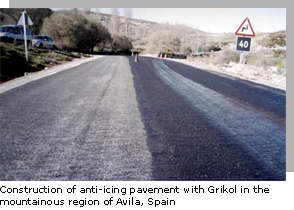After more than 2 million square meters used Grikol pavement, experience from Russia show that thin, rough pavements of "slurry-seal" and "Stone Mastic Asphalt" (3 -4 years service life) is the most efficient mixture. This type of Grikol pavement has a good de-icing effect the whole service life of the pavement. Traditional 5-6 cm thick pavements that needs to be restored (for example by "chip-seal") every 2-4 year, depending on traffic intensity, loses its de-icing effect in this process. Thin layers of Grikol pavement are most cost-effective and besides the de-icing effect these layers also work as a protective topping. Experience show that these Grikol pavements not only are effective on motorways but also on bridges and other crossings on which winter slipperiness occur much earlier than on the rest of the road.
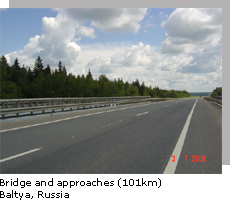
Test roads with Grikol made in Sweden have primary been documented and evaluated by subjective judgment.
Löttingevägen in Täby is the road that has been most carefully documented.
When it comes to Grikol pavements outside of Sweden Grikol has been applied in Finland, Island, Spain, Ukraine, USA and of curse in Russia.
From 2002 Russia Ministry of Transportation approves usage of Grikol. From 2005 Grikol is used in Ukraine where "macro-seal technology" from Akzo-Nobel is used to impart de-ice effect to macro-seal.
Grikol is successfully used on motor roads and bridges in Russia and abroad. What follows is information provided by NPO Rosdornii. Between 2009 and 2011 the following road sections with Grikol have been built on Federal motor roads in Russia:
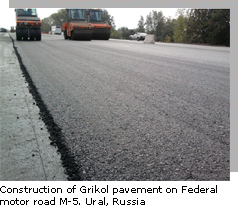
-М-9 Baltya, 101km, bridge and approaches (56000 m²)
-М-5 Ural, 202+690 – 213+900km (50000 m²)
-М-4 Don, bridge and approaches (36000 m²)
In 2004-2010 Grikol was used in the Ukraine, Spain, Italy and the USA. Lately about 500000 m² of anti-icing pavements have been built in Spain:
- Motor road AV-P -510 -Sepeda de la Mora- Baraxas-C500,
- PK6, 600-12, 600
- Motor road М601 Port Navaserrada
- Motor road N330 PK234+325-PK245+325 and others.

About 150000 m² of anti-icing pavements with Grikol were built in Italy:
- Motor road А-1 del Sole, North of Rome
- Motor road A-7 Milan, Genuia
- Motor road A-6 Turin, Savona and others.
In these countries Grikol anti-icing pavements are mainly constructed with bituminous emulsions (cold technology).
In 2009 a road section with Grikol was built in New-York (USA). Winter 2010 operation gave good results.
Grikol
®
Grikol composition and production technology is protected by European Patent.
Early experiences of Grikol in Sweden
Totally there have been nine test roads with GriKol made in Sweden, eight of them in and around Stockholm and one of them in southern Sweden. The test roads had a total length of 10km. For these roads there has been delivered about 200 tons of Grikol.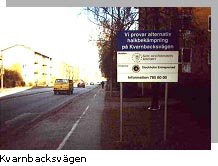
The earliest test road was made autumn 1993 - Kvarnbacksvägen, Bromma northwest of Stockholm. This Grikol pavement was 400m long and had a upper layer of HABS16 (6,3 weight% Bitumen). During four winter seasons this road was not salted and still showed the same good quality as the nearby salted roads. During lower temperatures (about -5 °C) it actually showed slightly better results. Kvarnbacksvägen has some heavy traffic load, about 17.000 vehicles per day. This test road show good quality during its whole service life.
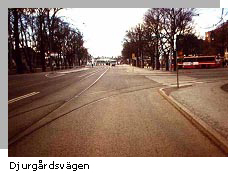
In the summer of 95 and 96 a pavement with Grikol was made out on Djurgården, one of Stockholm inner-city recreation areas with a small amount of traffic, mostly bus traffic. On this road there was some complimentary sanding done because of the small amount of traffic which did not erode forth enough Grikol out of the Bitumen.
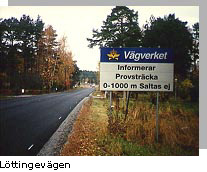
In the autumn of 95 there was made a 1km long test road on Löttingevägen in Täby, about 20km north of Stockholm. This test road has carefully been followed-up by the staff at Vägverket who has a road station right next to it. For more information, please read the presentation below and table with follow-up data. This Grikol pavement was made with HABS 12 (6.6 weight% Bitumen85).
Experience from Djurgårdsvägen and Löttingevägen indicate that Grikol pavements is more sensitive to that the asphalt is mixed in a correct way and that the paving is made during favorable conditions to get an as good quality on the pavement as possible *(read more about this further down). The amount of salt released from the Grikol pavement is in direct proportion to the erosion of the road. If the amount of traffic is 1000 vehicles per day and the frequency of studded tires is 35%, the amount of salt released from the pavement will be about 4,4g/m² (per year). This is a drastic reduction compared to regular salting of our roads.
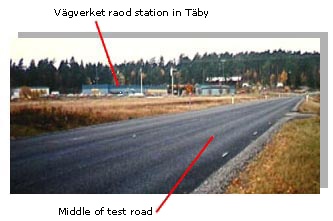
In 1995, Vägverkets road station by Löttingevägen in Täby was responsible for the winter maintenance of 350km of public roads. Part of this responsibility was European highway E18 and E4. Four function leaders were responsible and they used 27 different vehicles for this task.
This Grikol road was made autumn of 95 and the conclusion was that this road worked really well. Practically the only maintenance done was when the amount of falling snow was more than 2cm. Therefore the need for maintenance was reduced by 70% (read more under table with follow-up data).
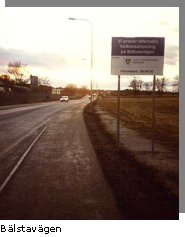
In autumn of 96, on Bälstavägen west of Bromma Airport, there was made a 1km long test road with Grikol. Experience from past winter seasons has shown good result in both de–icing effect and better friction quality. Also in the season of 96 there was made a 10.000 m² pavement with Habs16, 100 kg/m² and with 3% of Grikol filler on Hägerstensvägen, south of Stockholm right next to Aspudden.
Vattenbyggnadsbyrån (the water build bureau) has made measurements regarding the salt emission but could not make out any univocal results. However, they did make clear that the major component of Grikol is NaCl (read more about the structure of Grikol below).
The conclusion of these winter seasons is that Grikol pavements do have a good de–icing effect and that the pavements do not show any sign of abnormal erosion or decomposition.
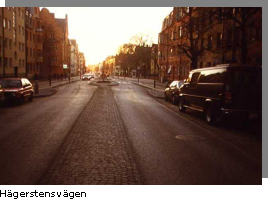
One problem with constructing Grikol pavements in Stockholm is that “Stockholm road and real estate-office” are responsible for the pavements and the costs for them while the district committee is responsible for the winter maintenance costs for most of the roads in Stockholm. This is why “Stockholm road and real estate -office” are not benefiting from the reduced winter maintenance costs (a Grikol pavement is about 25% more expensive than a regular pavement but will compensate for all its costs through reduced maintenance even during its first year in use).
Grikol consists of 80% NaCl, 10% CaCl2 and 10% Siakor.
Siakor is a silicon–organic compound with water rejecting and freezing point lowering properties.
A Grikol pavement has its freezing point at about –6 °C. Siakor also reduces the corrosion damage by binding the redundant chlorides from Grikol. Grikol also exists in a mixture specially developed for bridges and other crossings. This mixture contains an extra amount of corrosion inhibitors to prevent corrosion damage on the structures.
Grikol was developed in the 80s by the Russian research and production–institute “NPO ROSDORNII” and today the usage of Grikol on Russian roads are increasing. From 2002 the Russia Ministry of Transportation approves usage of Grikol. From 2005 Grikol is also used in Ukraine. There has also been some test roads made in Finland, Spain and on Island.
*Experience and results from the Swedish test roads show that Grikol has a good de–icing effect and that it does not cause any negative side effects to the firmness of the pavement. However, there have been some questions regarding two of the test roads, if it possibly was Grikol who caused the abnormal decomposition or not.
The developer and manufacturer of Grikol "NPO Rosdornii" claim that Grikol does not cause any negative side effects to the pavement. The reliability of this statement is confirmed by the fact that Rosdornii have made more than 2 million square meters of Grikol pavement in Russia without any sign of abnormal decomposition and that the Russia Ministry of Transportation approves usage of Grikol from 2002. We have also received information from Italy where there have been no sign of such decomposition.
More likely the experienced problems have its root in a defective durability of the pavement, which is a major and recurrent problem in Scandinavia. Read more about this here: Beständighet hos beläggningar. State of the art. (Only in Swedish)
This is why it is so important that the asphalt is mixed in a correct way and that the paving is made during favorable conditions, to get an as good quality on the pavement as possible.
© EEE&G Consulting. All rights reserved.
